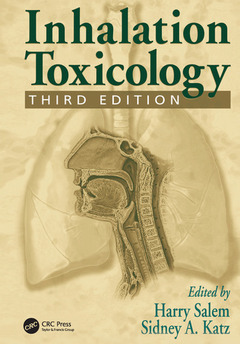Description
Inhalation Toxicology (3rd Ed.)
Coordinators: Salem Harry, Katz Sidney A.
Language: English
Subjects for Inhalation Toxicology:
Keywords
Inhalation Toxicology; Haber’s Law; lung-on-a-chip; PBPK Model; Risk Assessment; asbestos; Pulmonary Inammation; nanoparticles; Crystalline Silica Exposed; Particulate Matter Deposition; Pulmonary Brosis; PDMS Membrane; Sulfur Mustard; Phosgene Exposure; Human Small Airway Epithelial Cells; Nanotechnology Based Consumer Products; Toxic Load; ERPGs; Riot Control Agents; Crystalline Silica; Amphibole Asbestos; Small Airway Remodeling; Human COPD; Probit Parameters; Chrysotile Bers; CSCs; AEGL Value; Liquid Plugs
Publication date: 10-2016
· 17.8x25.4 cm · Paperback
Publication date: 08-2014
768 p. · 17.8x25.4 cm · Paperback
Description
/li>Contents
/li>Readership
/li>Biography
/li>
The lungs provide a significant opportunity for the introduction of both therapeutic and toxic chemicals into the human body. In occupational and domestic environments, hazardous chemicals can enter the body through the lungs via gases, aerosols, and particulates from natural and anthropogenic sources. Fully updated with new research and discoveries since the last edition, Inhalation Toxicology, Third Edition presents contributions from internationally recognized scientists in the academic, commercial/industrial, and governmental sectors. A pragmatic resource for practicing professionals and students, the book comprehensively examines the relationship between the respiratory system and the toxicology of inhaled substances.
Topics include:
- Regulatory aspects of exposure and testing
- Testing equipment and procedures
- Respiratory allergy and irritation of the respiratory tract
- Risk assessment
- Toxicology theory
- Toxicology modeling
- Toxic effects of some individual toxicants
New topics in this third edition include collection and characterization of airborne particulate matter, the inhalation toxicology of asbestos fibers and nanoparticles, and the development of lung-on-a-chip technology for predicting in vivo responses. Each chapter concludes with thought-provoking questions and answers, enhancing the book?s educational utility.
Collection and Characterization of Particulate Matter Deposition. Nose-Only Aerosol Exposure Systems: Design, Operation, and Performance. Lungs-on-a-Chip. Human Health Risk Assessment of Inhaled Materials. Application of Inhalation Toxicology Concepts to Risk and Consequence Assessments. Time Scaling of Dose and Time to Response: The Toxic Load Exponent. Improper Use of Haber’s Law Results in Erroneous Fatality Estimation from Predictive Models. Physiologically Based Kinetic Modeling of Inhalation. Nanomaterial Inhalation Exposure from Nanotechnology-Based Consumer Products. Influence of Physicochemical Properties on the Bioactivity of Carbon Nanotubes/Nanofibers and Metal Oxide Nanoparticles. Inhalation Toxicology of Riot Control Agents. Incapacitating Agents. Exposure to Ammonia. Serpentine and Amphibole Asbestos. Pulmonary Primary Cells Cocultured in a Novel Cell Culture System, the Integrated Discrete Multiple Cell–Type Coculture System (IdMOC): Pulmonary Cytotoxicity of Eight Cigarette Smoke Condensates and Nicotine. Animal Models of Chronic Obstructive Pulmonary Disease (COPD). Toxic Inhalation Injury: Management and Medical Treatment. Transcriptomic Responses to Crystalline Silica Exposure. Mechanisms Involved in the Inhalation Toxicity of Phosgene. Chemical Warfare Agents and Nuclear Weapons. Emergency Response Planning Guidelines. Safety Assessment of Therapeutic Agents Administered by the Respiratory Routes. Index.
Harry Salemis the Chief Scientist at the U.S. Army Edgewood Chemical Biological Center. He has been a visiting professor at Drexel University, Rutgers University, Temple University, and the University of Pennsylvania and he has held a variety of positions in the pharmaceutical industry and in commercial toxicology laboratories. He was the editor-in-chief of the Journal of Applied Toxicology and is on the editorial board of the Journal of Inhalation Toxicology. He was the 2001 Society of Toxicology Congressional Science Fellow, and is a Fellow of the New York Academy of Sciences, the American College of Clinical Pharmacology, the American College of Toxicology, and the Academy of Toxicological Sciences.
Sidney A. Katzis a professor of chemistry at Rutgers University. He has been a visiting professor in Canada, England, Germany, Hungary, Slovenia, and South Africa and has held research positions with E.I. duPont de Nemours and Company and with the R.M. Hollingshead Corporation. He has been a research fellow at the U.S. Army Edgewood Chemical Biological Center. His research activity is in environmental bioanalytical chemistry. From 1997 to 2002, he was a New Jersey commissioner for hazardous waste facilities siting.




